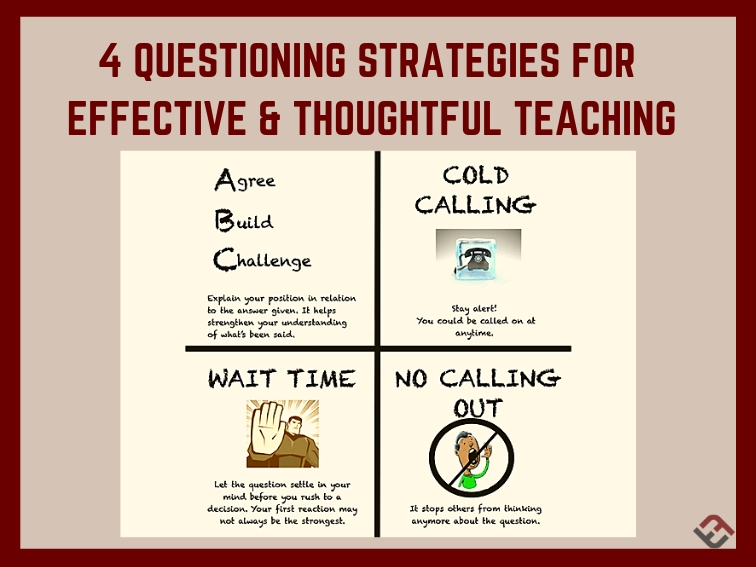4 Questioning Strategies For Effective & Thoughtful Teaching
by TeachThought Staff
This is the first article in a series of 4 discussing strategies to assist in becoming a better teacher. Each article is based around a poster that I have up in my classroom, with each poster having 4 sections that deal with a general topic I want to work on in my teaching: Questioning, Feedback, Classroom expectations, and Listening.
Questioning can be an enormously powerful weapon in the teacher’s arsenal but can be equally ineffective if not applied with diligence.
There are numerous excellent discussions to be found on effective questioning, especially in relation to the types of questions to ask, but I decided to create a visual representation that I could pin up on my wall of what I thought were the cornerstones of effective questioning. The poster is for me, and the students, and is to remind us both of the questioning routines in the room.
See also Types Of Questions For Teaching Critical Thinking
4 Questioning Strategies For Effective & Thoughtful Teaching
1. Agree-Build-Challenge
The first quadrant ‘Agree Build Challenge’: is very effective in deepening thoughts, as students are asked to either agree with another student’s response and justify their choice, or build on it, or disagree with it and state why, with an opposing view. It’s a great way to keep students on their toes, but also to encourage them to think deeply about the topic at hand. Some fantastic discussions have arisen as a result of this method, and even those not directly involved are still engaged as they side with one of the views.
2. Cold Call
The 2nd quadrant is ‘Cold Calling’. This is effective as it also keeps students on their toes as they know that they could be asked a question at any time, regardless of their hand is up or not. It builds a culture of alertness in the room. Even those who don’t know the answer are returned to after the answer has been generated from the room and must contribute then, thus preventing the opt-out.
3. Wait
The 3rd quadrant is perhaps my weakest point in questioning – waiting for the question to sink in before I call on a student. It’s especially hard if a student immediately raises their hand and is clearly keen to answer.
But waiting serves many purposes:
- it lets the whole groupthink before the answer is given to them
- it makes the person about to answer think that little bit more to refine their thoughts before offering to the group
- it lets you gauge the groups’ attentiveness to the question: who’s thinking about it and who’s not
- and finally, it encourages more participation as students know that it’s not first past the post when a question is posed. I take several answers before commenting and often ask for ABC on responses offered.
4. No Calling Out
The final quadrant is a must in any classroom. Preventing calling out is essential because when students yell out answers to questions it stops others from thinking about the question. Students soon work out that the work has been done for them – there’s no point in still thinking about the question anymore, which prevents any depth of thought-form from happening.
Even if calling out is still a habit in your room, don’t respond to the answers – make it clear that you don’t just take the first response and that’s it. Students soon learn that calling out has no value or advantage, and relatively quickly form better answering habits.
Above all, these techniques seem to create deeper thinking from my students, and a more productive and engaging classroom. Try them out and see if they help you too.
4 Questioning Strategies For Effective & Thoughtful Teaching
